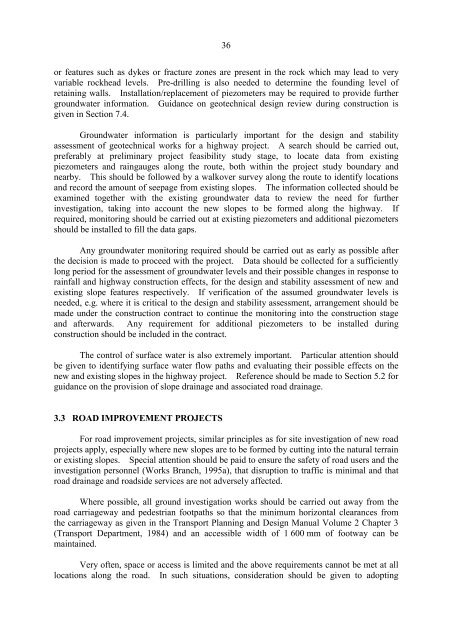Highway Slope Manual
Highway Slope Manual
Highway Slope Manual
Create successful ePaper yourself
Turn your PDF publications into a flip-book with our unique Google optimized e-Paper software.
36<br />
or features such as dykes or fracture zones are present in the rock which may lead to very<br />
variable rockhead levels. Pre-drilling is also needed to determine the founding level of<br />
retaining walls. Installation/replacement of piezometers may be required to provide further<br />
groundwater information. Guidance on geotechnical design review during construction is<br />
given in Section 7.4.<br />
Groundwater information is particularly important for the design and stability<br />
assessment of geotechnical works for a highway project. A search should be carried out,<br />
preferably at preliminary project feasibility study stage, to locate data from existing<br />
piezometers and raingauges along the route, both within the project study boundary and<br />
nearby. This should be followed by a walkover survey along the route to identify locations<br />
and record the amount of seepage from existing slopes. The information collected should be<br />
examined together with the existing groundwater data to review the need for further<br />
investigation, taking into account the new slopes to be formed along the highway. If<br />
required, monitoring should be carried out at existing piezometers and additional piezometers<br />
should be installed to fill the data gaps.<br />
Any groundwater monitoring required should be carried out as early as possible after<br />
the decision is made to proceed with the project. Data should be collected for a sufficiently<br />
long period for the assessment of groundwater levels and their possible changes in response to<br />
rainfall and highway construction effects, for the design and stability assessment of new and<br />
existing slope features respectively. If verification of the assumed groundwater levels is<br />
needed, e.g. where it is critical to the design and stability assessment, arrangement should be<br />
made under the construction contract to continue the monitoring into the construction stage<br />
and afterwards. Any requirement for additional piezometers to be installed during<br />
construction should be included in the contract.<br />
The control of surface water is also extremely important. Particular attention should<br />
be given to identifying surface water flow paths and evaluating their possible effects on the<br />
new and existing slopes in the highway project. Reference should be made to Section 5.2 for<br />
guidance on the provision of slope drainage and associated road drainage.<br />
3.3 ROAD IMPROVEMENT PROJECTS<br />
For road improvement projects, similar principles as for site investigation of new road<br />
projects apply, especially where new slopes are to be formed by cutting into the natural terrain<br />
or existing slopes. Special attention should be paid to ensure the safety of road users and the<br />
investigation personnel (Works Branch, 1995a), that disruption to traffic is minimal and that<br />
road drainage and roadside services are not adversely affected.<br />
Where possible, all ground investigation works should be carried out away from the<br />
road carriageway and pedestrian footpaths so that the minimum horizontal clearances from<br />
the carriageway as given in the Transport Planning and Design <strong>Manual</strong> Volume 2 Chapter 3<br />
(Transport Department, 1984) and an accessible width of 1 600 mm of footway can be<br />
maintained.<br />
Very often, space or access is limited and the above requirements cannot be met at all<br />
locations along the road. In such situations, consideration should be given to adopting

















